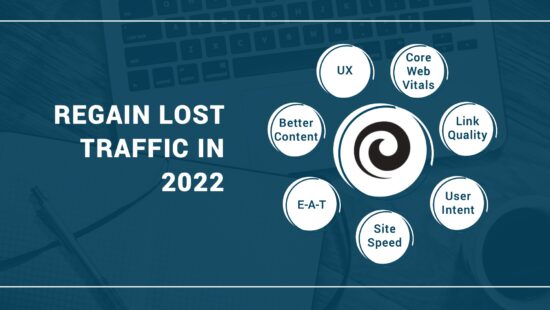From site speed to link spam, here is how to recover lost traffic in 2022.
Navigating Google updates, algorithm changes, and diagnosing specific causes of traffic loss can be challenging. Throughout the past year, Google has been more aggressive, rolling out changes to their search algorithm, launching three Core Updates along with a variety of more narrowly focused improvements during the year. Complicating things further, many of these updates overlapped or occurred within the same date range, making it more difficult to understand which update(s) may have caused traffic & ranking loss for webmasters.
If your SEO traffic is on the decline, let’s take a look at three potential reasons why and discuss how to reverse the trend heading in 2022.
1. Page Experience, Site Speed, and Core Web Vitals
The first phase of Google’s Page Experience Update had a three-month rollout this past summer, concluding in early September. This update rewards secure & fast-loading pages on mobile devices which pass Core Web Vitals requirements as described by Google. While the search impact thus far has been largely flat, we’ve seen numerous websites in competitive verticals lose mobile traffic throughout the update. Further, Google has announced they are bringing this update to desktop search results in the first quarter of 2022, presenting an opportunity to improve existing site performance while staying ahead of future updates. If you lost mobile SEO traffic in late summer and failed the new requirements, it may be worthwhile spending time improving your site’s Page Experience and Core Web Vitals metrics.
Not sure where to begin? Google has recently updated their PageSpeed Insights and Lighthouse tools which can help you better understand specific causes of slow site speed and pinpoint Core Web Vitals failures. Search Console offers additional insight regarding your website’s performance, and WebPageTest.org can help developers get a deeper look at the situation.
It’s important to note this is largely a page-level update, so webmasters will need run diagnostics at the URL level. For larger websites, this can present a significant time investment and may be why Google gave such advance notice of this update. To help diagnose more quickly, begin by analyzing your website’s pages on a template or page-type level to uncover solutions that can likely be applied to all pages of that page type and template.
Taking things a step further, it may be worth utilizing cloud hosting services like AWS or Cloudflare for your website. These solutions have built-in speed and security optimizations that can help your site load more quickly on desktop and mobile devices. You may also choose to hire a professional who can make a complex technical project more approachable for you & your developers.
2. Being authentic and serving your users
The latest version of Google’s Search Quality Guidelines refines their guidance for content quality, especially pertaining to YMYL industries (finance, healthcare, e-commerce, and so on). We’ve seen content quality consistently be a key indicator of how your website will perform throughout a Core Update, so it’s always a good idea to stay on top of Google’s recommended best practices and produce content that meets your users’ needs – especially as compared to your competitors. If you lost SEO visibility during June, July, or November, a Core Algorithm update could be the reason, and it’s likely a lack of content quality or a poor user experience may be reasons why.
When analyzing your site’s content, it’s important to ask yourself:
- Is the content on your website authored by a topical expert, and are you proving this in your author profiles and bylines? This is especially important in YMYL categories to convey E-A-T, although there are certain situations where it may not be needed.
- Are you removing bias and presenting both sides of a story? The pros, cons, and alternatives of a product? The differences between Option A and Option B? In most situations, it’s important to paint a complete picture of the topic at hand to best serve your users and encourage Google to rank your content.
- Gone are the days of trying to meet a minimum word count to rank well. Instead, put yourself in the users’ shoes and focus on intent – for example, a user searching for “Nike Sneakers” doesn’t need a 500-word history of the brand, rather a category page with size, color, and price filters to meet their needs.
- Are there excessive ad units on the page, especially ads above the fold, interstitials, popups, or overlays? When possible, advertising should complement your content, not distract from it.
- Is your content easy to consume? Comprehensive information is great, but formatting long paragraphs into lists, bullet points, tables, and so on can help users better digest what you have to say (and can help you capture SERP features in Google, too).
- Are media objects (videos, images) or references (external links to trusted citations) integrated within your content? This isn’t always needed but can further help position you as a trusted authority and gain more SEO traffic.
3. Link spam & guest blog posts
Quality, relevant backlinks are still a strong indicator of how well a site will rank, and obtaining natural links remains one of the most challenging areas of SEO to get right. Google has a long history of taking action against unnatural links, and we’ve seen the search engine continue to filter out links they believe violate their webmaster guidelines in 2021.
Google rolled out their latest “Link Spam” Update in July, which specifically targets links from guest blog posts, affiliate links, and links within sponsored content. Why are they focusing on filtering links from these areas? These link tactics scale incredibly well but are often low-value and low-effort. They form easily detectable unnatural link patterns and pose a long-term risk. This update reminds us of something we’ve seen over and over throughout the years: when a link-building approach becomes too popular, Google will eventually take action. No surprise here, Google is algorithmically filtering out links fitting these criteria.
If you experienced a drop in rankings during late July and know you may have these types of links in your backlink profile, it’s very likely some of those links which once helped you rank are no longer providing any value. If you haven’t already, a backlink audit and disavow may be in order, but proceed with caution – even Google acknowledges you can do more damage disavowing links if you don’t know what to look for. This includes relying on software to quickly identify “toxic” links; automated solutions are never a substitution for human review for such an important ranking factor.
So what can you do to replace lost link equity? It’s important to keep in mind that natural link acquisition can be THE most effective part of your SEO strategy. Earning natural links from trusted websites, industry publications, and media outlets will provide safe, effective, and long-lasting results. Acquiring these types of links on a regular basis relies on the quality of your content and its audience, so the best approach marries your outreach strategy with your content plan and editorial calendar.
Wrapping things up
2021 has been a challenging year for many of us. Losing traffic during this time has many potential causes but also presents opportunities to better focus your SEO efforts heading into 2022. Taking a holistic approach to your SEO efforts across technical, content, links, speed, and UX factors will help put you in the best possible position to recover your rankings and reduce the risk of being negatively affected by a Google update moving forward.




